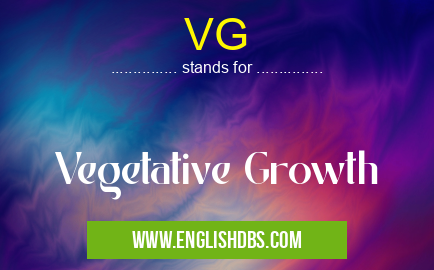What does VG mean in UNCLASSIFIED
When certain environmental cues (e.g., day length, temperature) are met, plants transition from vegetative growth to reproductive growth. This involves the initiation of flowering and the production of seeds.

VG meaning in Unclassified in Miscellaneous
VG mostly used in an acronym Unclassified in Category Miscellaneous that means Vegetative Growth
Shorthand: VG,
Full Form: Vegetative Growth
For more information of "Vegetative Growth", see the section below.
- VG stands for Vegetative Growth. It is a term used in the field of horticulture and refers to the stage of plant development prior to reproductive growth.
Characteristics of Vegetative Growth
- Leaf Production: During vegetative growth, plants focus on producing leaves to increase their photosynthetic capacity.
- Stem and Root Development: Vegetative growth involves the elongation and branching of stems and roots to establish a strong foundation for the plant.
- Nutrient Uptake: Plants absorb essential nutrients from the soil during vegetative growth to support their growth and development.
- Hormonal Regulation: The hormone auxin plays a key role in stimulating cell division and promoting vegetative growth.
Factors Affecting Vegetative Growth
- Light Intensity: Plants require adequate sunlight to produce photosynthetic energy for vegetative growth.
- Temperature: Optimal temperatures vary among plant species and can influence growth rates.
- Water Availability: Water is essential for cell expansion and nutrient transport.
- Nutrient Availability: Macronutrients (e.g., nitrogen, phosphorus, potassium) and micronutrients (e.g., iron, manganese, zinc) are necessary for healthy vegetative growth.
Transition to Reproductive Growth
Essential Questions and Answers on Vegetative Growth in "MISCELLANEOUS»UNFILED"
What is vegetative growth (VG)?
Vegetative growth (VG) refers to the non-reproductive growth phase of a plant's life cycle, characterized by the development of new shoots, leaves, and roots. It occurs before the plant enters the reproductive phase, which includes the production of flowers and seeds.
What are the key characteristics of VG?
VG is typically marked by:
- Rapid cell division and expansion
- Increased biomass (weight and size)
- Development of vegetative organs (shoots, leaves, roots)
- Absence of reproductive structures (flowers, seeds)
What factors influence VG?
VG is influenced by various factors, including:
- Environmental conditions (light, temperature, water availability)
- Genetic makeup of the plant
- Nutrient availability
- Hormonal regulation (particularly auxins and cytokinins)
What are the benefits of VG for plants?
VG enables plants to:
- Establish and expand their root and shoot systems
- Increase their capacity for photosynthesis and nutrient uptake
- Adapt to changing environmental conditions
- Recover from damage or stress
How can VG be controlled and manipulated in horticulture?
VG can be controlled and manipulated through techniques such as:
- Pruning and pinching to encourage or discourage specific growth patterns
- Fertilization to provide nutrients for growth
- Light manipulation to regulate plant morphology
- Hormonal treatments to promote or inhibit growth
Final Words:
- VG is a horticultural term that refers to the phase of plant development prior to reproductive growth.
- During vegetative growth, plants focus on leaf production, stem and root development, nutrient uptake, and hormonal regulation.
- Various environmental factors influence vegetative growth, and when conditions are optimal, plants transition to reproductive growth to ensure their survival and propagation.
VG also stands for: |
|
| All stands for VG |
